| We had a couple of days at Oceano while my brother and his family
arrived from the UK and recovered from jet lag. Just as well because we had
a few problems of our own. We had to reconfigure the RV to cope with five
extra people and organise an oil change and fixing the brakes. It gave us
little time to admire the scenery but we did realise we were now into
country which could support palm trees even if it wasn't the Caribbean. | 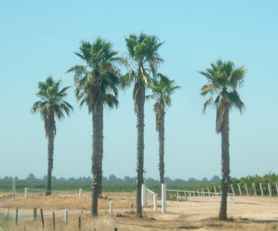 |
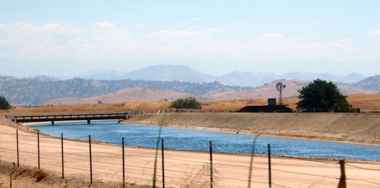 | This is primarily
a desert area which has been made fertile by the use of prodigious amounts
of water. Much of this is carried from the Colorado River basin in aqueducts
such as this one feeding the San Joaquin Valley. They do say that most of
the wars in the future will be over water. Politically that is happening now
as California tries to retain its use of water (and other) resources from
other states no matter what. |
| But this area is separated from the sea by many dunes somewhat
reminiscent of the Sahara. In fact we came across an area known as Little
Sahara. It was also much colder than we expected because of sea mists
affecting just the coast itself, just as we had found in Oregon.. |  |
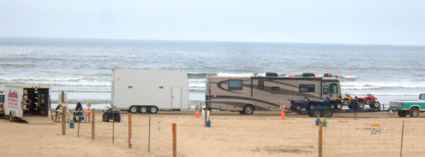 | But the beach was
much more congested with RVs parking direct on the beach and ATVs in
profusion. It was actually very crowded and very noisy. With no facilities
everybody was running generators for air conditioning despite it being
barely warm enough. |
| Meanwhile just a mile inland was a major market garden industry.
These are hydroponically grown lettuce seedlings but the fields were full of salad
crops being harvested by armies of migrant Mexican workers. The supermarkets
stock familiar Mexican foods for them and half the population (including the
campers) spoke Spanish. The mayor of LA is now a Hispanic and almost a dozen
states now have a non-white majority. This will lead to fundamental change
here. |  |
 | But for the moment
we were only looking at the scenery and we set off to travel Route 1 up the
coastline to San Francisco. Oceano is the southern end of Pismo Beach which
is the bay we had camped in just south of the old settlement of San
Luis Obispo which was founded by Spanish monks in the early 1700s. |
| As a side trip we stopped at the Madonna Inn there just to admire
the kitsch and try out the coffee and cakes. Everything about this place is
way over the top from the styling of the rooms (way outside our price
bracket) to the size of their cakes! | 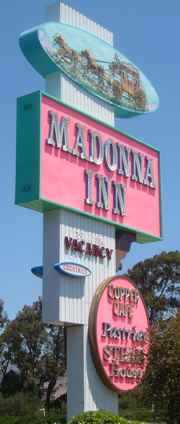 |
 | All the rooms are
individually styled. You can buy postcards of them in the cafe. It all
seemed a bit pink and sugary to me. Even the restrooms were way over the top
in decor. |
| The cakes were outrageous. We were actually offered a takeout box
as they were delivered. This was lemon and coconut and mine was apple spice
complete with huge curls of bright pink icing. Just as well we accepted the
boxes because it took us three days to eat them. |  |
 | Moving on we really
ran into the sea mist. One mile inland and it was 90°F
or more but as you reached the sea it dropped 40°F. The visibility also
vanished although the cover was only about 100ft thick. This small power
station epitomised the effect as the three chimneys vanish into the mist. |
| A couple of bays further on and we found the elephant seal
breeding grounds. These huge beasts are very ungainly out of the water. This
bull was about 100 yards away and was trying to keep his harem in order with
some healthy bellowing. |  |
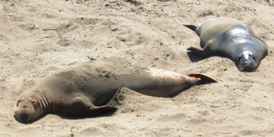 | But others (probably
juveniles) had moved away closer to the hordes of onlookers and had just
flopped out in the heat of the sun. There were some in the water but you
only saw their noses every couple of minutes (if you were lucky). |
| The parking lot did contain a camping bus (we saw several of
these in this week). The occupants sleep in bunks in the rear part and the far side opens up
to give them access. They seemed to be occupied largely by Germans, and surprisingly, a much older generation of people than one might have expected.
The buses were registered in Alaska (presumably for tax reasons). |  |
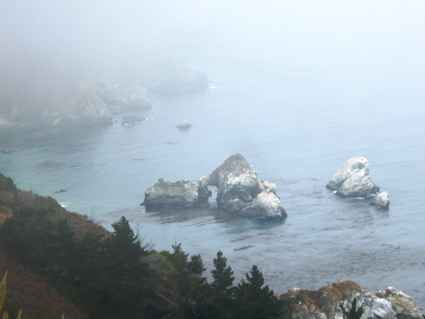 | There are a number
of islets along the coast. Often these are volcanic in origin having been
thrown here as the result of some ancient eruption. This one was of note
because of the erosion forming a natural bridge. You can see the impact of
the mist in reducing visibility.. |
| Sometimes you got a bit where the sun shone through onto one of
the sandy
beaches. These were often deserted. These Californian beaches are quite cold
because of the cold current flowing down from Alaska,
the surfing is not good enough, and there is nobody around for the surfers to pose
for. | 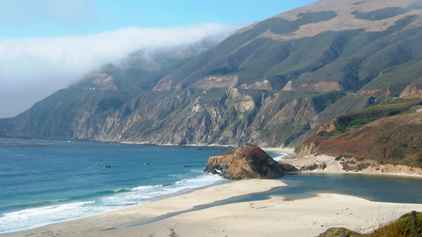 |
 | Highway 1 (which
runs from Mexico to Vancouver) clings to the edge of the coast and follows
the cliffs. This makes for quite a lengthy and slow drive particularly in a
long vehicle. The mist does not offer many glimpses of the coast. |
| And so we travelled north up past Monterey and just beyond to
Marina Bay where we stopped for a couple of nights in order to visit the aquarium in
Monterey. | 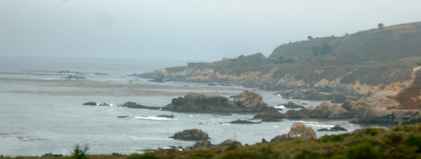 |
|